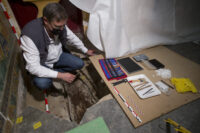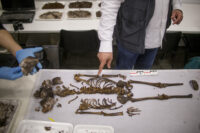 The remains of a little blonde-haired girl have been discovered buried under the royal chapel of the Gothic Palace in the Real Alcázar of Seville, southern Spain. This is the first burial ever discovered in the Real Alcázar palace.
The remains of a little blonde-haired girl have been discovered buried under the royal chapel of the Gothic Palace in the Real Alcázar of Seville, southern Spain. This is the first burial ever discovered in the Real Alcázar palace.
The remains were discovered last month during restoration work on the 16th century ceramic tiles. Eight inches under the floor of the chapel’s main altar archaeologists found a lead sarcophagus 46 inches long, 16 inches wide at the head, 12 inches wide at the feet and a foot deep. Inside was a deteriorating wood coffin and the complete articulated skeleton of a child. Blonde hairs were found at the nape of her neck and a permanent molar indicates she was about five years old when she died. . Fragments of her clothing — fabric, shoe leather and two mother-of-pearl buttons — were also found in the coffin. Next to the coffin were six boxes containing an earthy substance that will be excavated and analyzed.
 So far there is no evidence pointing to the child’s identity, no seal or mark on the lead coffin or in the surviving wood. The fact that she was buried in a lead sarcophagus indicates she belonged to a very wealthy family, as does the palace location. Radiocarbon dating results aren’t expected for another three months, but the sarcophagus style suggests it dates the 13th-14th century.
So far there is no evidence pointing to the child’s identity, no seal or mark on the lead coffin or in the surviving wood. The fact that she was buried in a lead sarcophagus indicates she belonged to a very wealthy family, as does the palace location. Radiocarbon dating results aren’t expected for another three months, but the sarcophagus style suggests it dates the 13th-14th century.
Archaeologist Miguel Ángel Tabales, who is leading the research, is in no doubt that the altar of the chapel was not the little girl’s original burial place. He also believes she must have belonged to a very powerful family to be buried within the royal palace. His theory is that she was placed to the side of the altar when the chapel was repaved between 1930 and 1940. “We have not found any documentation to confirm it, but the lead coffin was surrounded by a cist [stone coffin] made from reused bricks held together with cement, materials that tell us it is from the first half of the 20th century,” he says. “My theory is that the workers found the sarcophagus in another area, opened it and, on seeing it was a corpse, decided to cover it decently and place it near the altar.”
Archaeologists and palace officials are on the lookout for the possible original location. They suspect there are more bodies to be found somewhere inside the palace, perhaps a crypt in the Gothic Palace built by King Alphonso X of Castile over the Almohad-era palace destroyed in the Christian reconquest of Seville.
Anthropologist Juan Manuel Guijo, who is in charge of studying the remains, hopes that the tests will provide information about the girl’s lineage, where she lived, the cause of death and the funeral rites performed at her burial. “She had her arms semi-flexed and crossed over her thorax,” notes Guijo. “And the body had not been tampered with. We will be able to extract her DNA from the root bulb of her hair [rather than the bones], because when the wood disintegrated, the bones came into contact with the lead, which alters the results of this test. If we find remains of oils, we will know if she was an important person and also if she had been embalmed, a ritual forbidden by the Catholic Church, but which the wealthy practiced in their quest for eternal life.”
I feel they should leave her be and just rebury her.
A permanent molar at age 5? Adult molars are usually the last teeth to emerge, usually around 11 or 12..
I think you’d be able to see a permanent molar developing a long time before it came in, no? (I had permanent teeth removed as a 7 year old before the baby teeth they’d have replaced had come out.)
It is wild to see how teeth are always an identifier. Even on something this old.
Maybe she was indeed slightly older than five, but how have they come to the conclusion that she was a girl in the first place?
Did they find two X-chromosomes, or have other hints been interpreted?
As the kid was found under the chapel of the “Gothic Palace” in the royal “Alcázar” in Sevilla (from Arabic اَلْقَصْر al-qaṣr, i.e. “castle”, itself from Latin castrum), and the archaeologists are on the lookout for the possible original location, if there really is a crypt in that chapel, they should be able to find it.
Very similar to the chapel picture from the linked El Pais article is this one:
upload.wikimedia.org/wikipedia/commons/9/9c/Capilla_del_Palacio_Gótico_del_Real_Alcázar_de_Sevilla.jpg
:hattip: